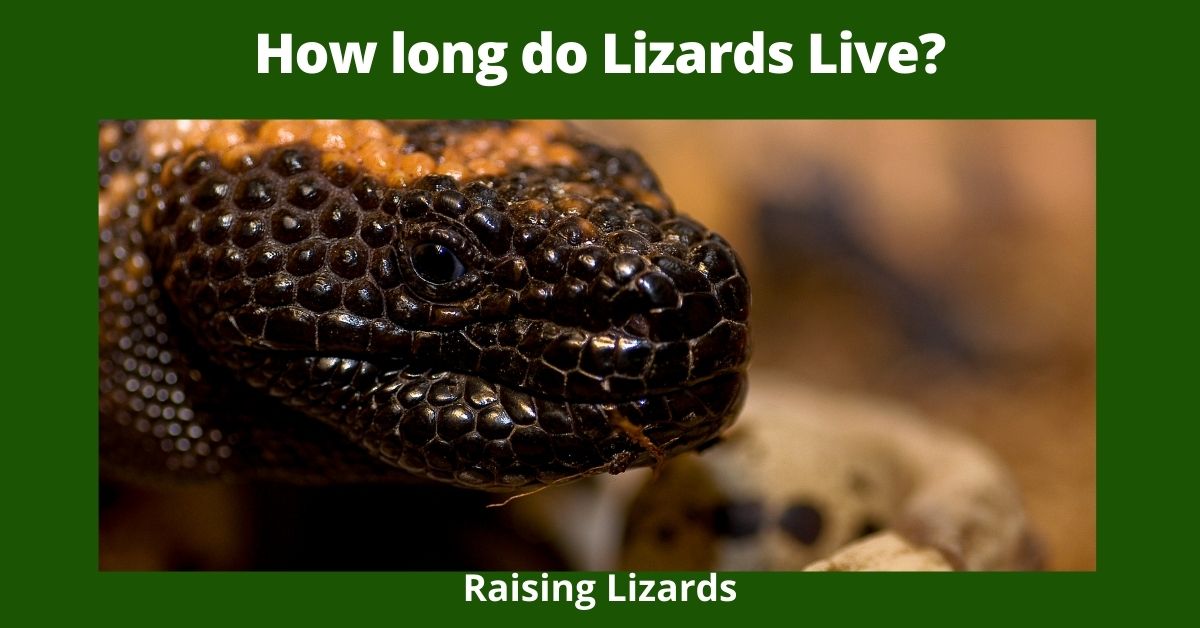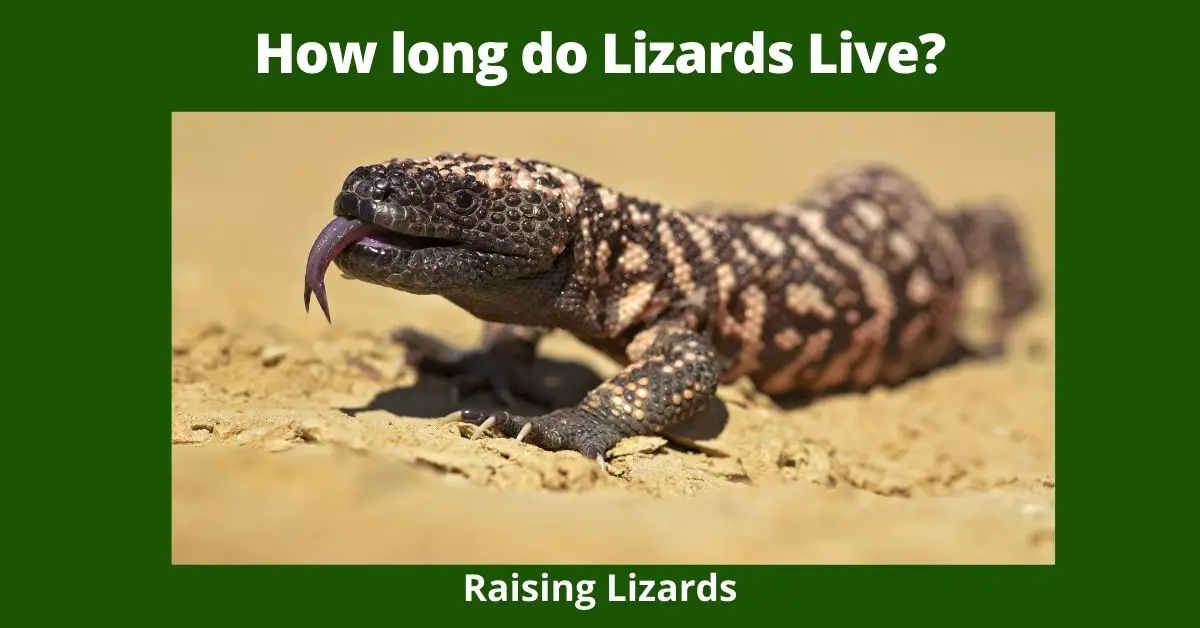Lizards Lifespans are from 5 years to in rare cases 30 Years
How long do Lizards Live?
Do you know how long lizards live? Lizards can have a lifespan of anywhere from one to twenty years, depending on the species. Some lizards grow very large, while others stay quite small. There are many different types of lizards, and they can be found all over the world! In this blog post, we will discuss the different types of lizards and their life spans. We will also explore some interesting facts about these creatures!
What are the Most Common Pet Lizards?
There are about 5000 different species of Lizards worldwide! How long do Lizards Live?
The Most Common Pet Lizards that are kept are:
- House Gecko – the House Gecko is a very common lizard indeed. It’s a lizard that is quiet and will not make too much noise, meaning it’s great for families with young kids. The House Gecko can be found all over the world in warm climates and they are also common to keep when you live in apartments as they like small spaces.
- Asian Water Dragon – this type of Lizard loves water so if you’ve got an aquarium set up already then it may be time to take your reptile collection one step further just fish by
- Gargoyle gecko – The Gargoyle gecko is a common pet found in North America. They are nocturnal lizard, which means they sleep during the day and are awake at night. These geckos have big eyes and make great pets for people who want something different!
- Leopard Gecko – The Leopard gecko is one of the most popular pet lizards because it is so hardy. This type of lizard can tolerate a wide range of temperatures, making it an ideal pet for those who live in colder climates or those who do not have a lot of experience taking care of reptiles.
- Painted Dragon – these lizards get their name from their bright colors that can be seen on their skin as well as their tails. Male painted dragons tend to be more vibrantly colored than females, but both sexes have patterns that look like paint drips. These lizards are native to Australia and New Guinea (where they are also known as “frilled dragons”).
- Bearded Dragon (Pogona vitticeps) The bearded dragon is known for its docile nature and ease of care. This lizard from Australia can reach a length of up to 24 inches with proper care. It has a reputation for being very friendly, coming when called by name and seeming to enjoy interacting with humans or other pets in their environment. They are also easy to handle; they do not tend to bite or scratch like some lizards will if provoked, although they may puff out their beard (throat). The most common pet species are the inland/central bearded dragon (Pogona vitticeps), which inhabits arid regions of Australia, and the Australian coastal bearded dragon (Pogona barbata), which is found near the coast.
- Blue Tongue Skink (Tiliqua scincoides) The blue tongue skink is a large lizard that can grow up to 24 inches in length. It is one of the most common pet lizards in Australia and has been introduced into other parts of the world as well. This species is known for its friendly disposition and calm nature, making it a good choice for a pet lizard. The blue tongue skink’s diet consists mostly of insects, but it will also eat small mammals, birds, reptiles, and fruit.
- Russian Tortoise (Testudo horsfieldii) – The Russian tortoise is a small to medium-sized tortoise that is found in the Middle East and parts of Asia. It has a high rate of reproduction and can live up to 50 years or more in captivity, making it a popular pet choice for those looking for a long-term commitment. The Russian tortoise is herbivorous and prefers to eat grasses, weeds, flowers, fruits, and vegetables.
- Iguana – The green iguana is a popular pet due to its relatively large size, colorful appearance, and docile nature. Most of the pets are wild-caught imports, although captive breeding has become more common in recent years. They can grow up to six feet long with proper care and live for 20–30 years.
- Crested Gecko (Rhacodactylus ciliatus) The crested gecko is one of the most popular reptiles kept as a pet today due to their gentle nature and ease of care. This lizard from New Caledonia grows to between five and eight inches long (including tail). It was originally thought that this species was extinct until it was rediscovered in 1994 by chance during
- American chameleon – The American chameleon (Chamaeleo calyptratus) is native to the southeastern United States. It is a large lizard, reaching up to 22 inches in length, and has a colorful body with a prehensile tail.
- Jackson’s Chameleon (Trioceros jacksonii xantholophus)The Jackson’s chameleon is found in East Africa and can reach lengths of up to 24 inches. This species is known for its bright colors and patterning as well as its docile nature. The Jackson’s chameleon is one of the most popular pet lizards in the world.
- Veiled Chameleon (Chamaeleo calyptratus)
What is the Lifespan of the Most Common Pet Lizards?
- Veiled Chameleon – They can live up to six years.
- Leopard Gecko – They can live up to 20 years.
- Green Iguana – They can live up to 30 years.
- Bearded Dragon -They can live up to 12 years.
- Cuban Knight Anole – They can live up to five years.
- Blue-Tailed Skink – They can live up to 15 years.
- House Gecko – They can live up to eight years.
- Mexican Beaded Lizard – They can live up to 12 years.
- Veiled Chameleon – They can live up to six years.
- Leopard Gecko – They can live up to 20 years.
- Green Iguana – They can live up to 30 years.
- Red-Eared Slider – They can live up to 25 years.
- Cuban Knight Anole – They can live up to five years.
Lizards can live up to 20 years in the wild
In the wild, lizards can live up to 20 years.
The average age of a lizard is five years.
The desert spiny lizard has the longest lifespan of any other type of lizard and it can live for more than 30 years in captivity. The shortest-lived types are geckos which only survive three or four days after being born.
There have been reports about some species living longer than others but those claims remain unproven at this time due to a lack of scientific evidence supporting them (e.g., there aren’t any studies on how long do lizards last). Some scientists believe that these reports may be false because they’re based on anecdotal observations rather than actual data collected from observing populations over many generations.)

Lizards come in a wide variety of shapes and sizes.
The smallest lizard is the goldfish-sized Jaragua sphaerocephalus, while the Komodo dragon is the largest at up to ten feet long and 330 pounds.
There are approximately 5,000 different species of lizards around the world.
They can be found on all continents except Antarctica.
Lizards have been around for about 250 million years making them one of the oldest reptile groups on Earth.
Despite their diversity, they all share some common characteristics including scaly skin, movable eyelids, four legs (or two legs and two arms), and a long tail.
While most lizards are terrestrial (live on land), some types live in trees or water such as the marine iguana (often seen swimming off the coast of Ecuador).
The Komodo dragon is an interesting example because it can be found both on land and at sea.
A few species are venomous while others have no teeth or only tiny ones like those on gila monsters. Many lizards also have long claws that help them climb up walls, trees, etc., but not all do (e.g., geckos don’t need any toes). Some even use their tail to escape predators by letting go when grabbed so they can run away with just one leg!
Lizards’ eyes come in different colors including brown, green, yellowish-green red, and black.
One of the most interesting things about lizards is their ability to change color in order to blend in with their surroundings (called cryptic coloration).
This can be seen in chameleons which can turn from light green to a dark brown, or even completely black!
Some species will also puff themselves up when they’re angry or scared to make themselves look bigger.
They can survive in a variety of Habitats, from Deserts to Rainforests
Lizards are very adaptive creatures. They can survive in a variety of habitats, from deserts to rain forests and everywhere in between, even urban environments. Lizards are found on every continent except Antarctica, but they are most diverse in the warmer climates of Africa, Asia and North America.
Most lizards have four legs with clawed feet that allow them to climb trees or run on the ground very quickly (though some species do not have forelimbs). The tail is long and used for balance when walking or running over rough terrain.
It can also be dropped if attacked by a predator as some lizard species grow another one later. A newly regenerated tail may look different than their original tails due to scar tissue formation during healing processes after being severed off completely; this means that it might not have scales anymore but rather a smooth surface instead.
They are cold-blooded reptiles with dry skin covered in scales, which helps them to retain moisture and stay cool in hot climates. They also have glands under their throats called parotid glands that secrete toxins used for defense against predators when threatened or attacked by larger animals.
Birds of prey like hawks or eagles will try swallowing whole lizards whole without chewing on them first before digesting these small creatures alive inside their stomachs due to lack of teeth capable of tearing apart tough fleshy meat pieces into smaller bits more easily during eating habits normally found within mammalian carnivores from land-living species like man’s best friend dogs who need help breaking down bones
Lizards are Ectothermic, which means they rely on their Environment to regulate their Body Temperature.
Lizards are cold-blooded, which means their internal temperature is the same as the ambient air or ground around them. This is why you’ll often see lizards sunning themselves on rocks or logs – they’re warming up!
Lizards can’t generate their own body heat, so they need to be in an environment where they can absorb warmth from the sun or air. If it’s too cold outside, lizards will become sluggish and may even die.
In the summertime, lizards have to watch out for overheating. They can regulate their temperature by moving into the shade or by panting, which helps them lose heat.

Some Lizards are Venomous, while others are Harmless.
The Lizards that are Venomous are:
- Mexican beaded lizard
- Gila Monster (Heloderma suspectum)
- There are two species of venomous lizard: the Gila monster and the Mexican beaded lizard. These lizards are slow-moving, large and heavy-bodied with short legs compared to other lizards. They have long tails that they can use for balance when climbing trees or running across loose sand or dirt
- They are not fast-moving animals but rather rely on their powerful jaws to kill prey quickly before escaping into burrows where they hide until it’s safe again. Their size makes them difficult targets for predators so these reptiles spend most of their time in hiding places such as cracks between rocks or under leaves where an attack would be less likely to succeed than out in open areas where predators have much easier access.
Final Thoughts – How long do Lizards Live?
Conclusion – If you are considering adding a lizard to your family, be sure to do your research first to find the right species for you. Each type of lizard has its own unique needs and requirements that must be taken into account before bringing one home. With proper care, lizards can make delightful pets that provide companionship


